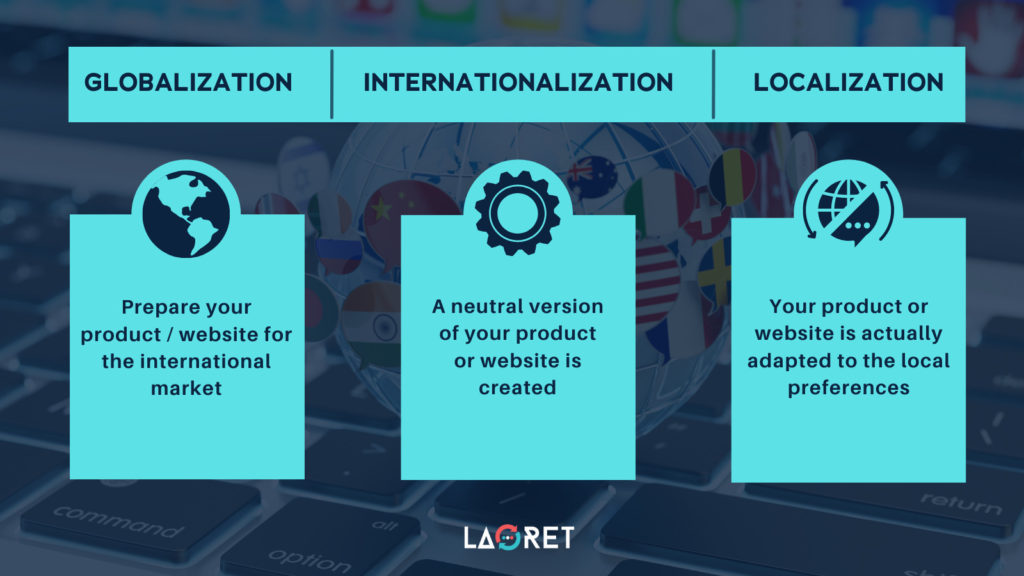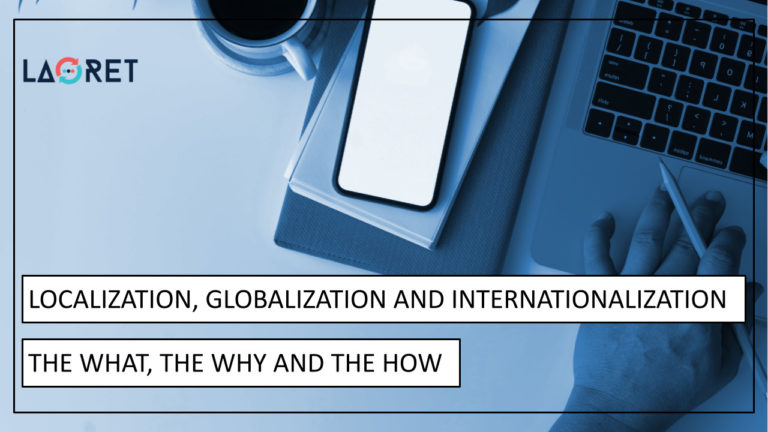Localization, Globalization And Internationalization: The What, The Why, And The How
Have you seen the terms Internationalization, Globalization, and Localization appear many times but you are still not quite sure what the difference is between them?
Then this is the blog for you to read. Learn about what each concept entails, what will be required to bring them to the best possible outcome, and how they all rely on one another in order to create a potent, multilingual brand.
Localization? Internationalization? Globalization? What Is The Difference?
First things first! Let’s have a global overview of what Internationalization, Globalization, and Internationalization entail before we dive into the specifics.
- Globalization starts from your unique business objectives and your target audience to prepare your product/website for the international market. Internationalization and Localization are both part of this process.
- Internationalization is the process that comes before any localization process. A neutral version of your website or software is created so it can more easily be adapted to other locales and languages.
- So, then what is localization? Here, your product or website is actually adapted to the local preferences in terms of culture, language, and technology.

Globalization: What Does It Involve?
Globalization is the inclusive process you apply when expanding into and operating within the international market. Your entire brand, products and services, as well as your digital presence will be transformed from a single-country perspective, to a multinational one, so that your operational model can be applied across various locations and companies. As a global strategy, both localization and internationalization fall under Globalization.
More specifically, globalization includes
- Thorough market research and data collection to truly understand your new audiences.
- Detailing a market entry strategy that works for you, whether it is through export, partnerships, mergers, and so on.
- Define the global branding strategy and determine to what degree your personal branding should be adapted to fit local preferences and cultures. Looking at McDonald’s, for example, you will still recognize the brand in any country based on their choice of colors, names, design, and logo. But the menu does undergo local changes depending on the dietary preferences or restrictions.
- Familiarize yourself with the local regulations you are entering into, so that all business can be conducted legally and securely.
- Be aware of how you can maintain the same level of excellence in service by delving into trade regulations and determining which shipping models and supply chains can be used.
- When it comes to your website, you will need to develop an integral website localization strategy that should include a strong international SEO strategy.
The Ins And Outs Of Internationalization
Internationalization is the process that takes place before you localize. It ensures that your products are ready for the localization process, and common errors and taxing workarounds can be avoided.
Sadly, not every business applies internationalization, and it can lead to localization services becoming more expensive and time-consuming. To effectively integrate the internationalization mindset into your development stage, plan out a strategy that makes it easier to implement. This involves addressing the following points from the start.
The User Interface (UI)
Localizing a UI can be an arduous task, but internationalization can make this process a whole lot easier by adapting it to fit a multilingual design. This includes:
- Images and colors to be easily adapted to local preferences. For example, avoid hardcoding images and provide your Language Service Provider (LSP) with editable formats.
- If you are translating into bidirectional languages such as Arabic or Hebrew, consider adding the markup in your DTD that supports this type of content and can identify the language. You can also add CSS support if your multilingual UI will appear in vertical content or other typography that does not feature Latin elements.
- Text expansion and contraction should always be kept in mind, and the UI should support languages that take up more space than others. German, for example, is a far more elaborate and verbose language than English due to the liberal use of compound nouns. Even a simple word can take up to 30% more space.
Strings And Data Formats
Strings should be developed, designed, and stored in a way that makes localization run more smoothly. This means that you should:
- Like we said before, avoid hard-coding at any cost and enable Unicode. The most widely used encoding is UTF-8.
- Also enable your coding to support local preferences including formats for dates and times, numbers, calendars, grammar forms, and so on.
- When it comes to dates and times, make sure that they are sorted in a format that will be easy to localize, for example, the ISO 8601 standard. The same goes for numbers. For example, the standard used for currencies is commonly ISO 4217, and UN M.49 for region codes.
Localization: How To Talk To Your International Markets
Of course, we’d like to share a few words on what localization itself actually entails. Localization goes beyond mere translation and adapts a product and content to the local culture in every possible way to bring it up to native standards. This involves adapting the content as well as graphics, colors, currencies, payment methods, legal requirements, and so on. And with the product already set up in a neutral framework to support localization, this process can be executed in the most cost-effective manner.
The content will be exposed to the Translation, Editing, and Proofreading (TEP) Process with consistent Quality Assurance applied. Typically, the localization process will be maximized within a Translation Management System (TMS) leveraged by a Project Manager who will select the right talent for each project. The TMS will also feature cutting-edge localization tools such as a CAT Tool and a Translation Memory, so that the process can be further streamlined.
A part of understanding localization services, also lies in understanding which services will work best for you. For example, it is highly likely that you will have source content that will need to be adapted to local audiences. But even if you don’t have source materials and want to create fresh content for specific locales, there is a service available called Transcreation. Much like localization, Transcreation created a fully native product. But with the added expertise of native copywriters, this multilingual content can be created from scratch.
Case Study In Effective Globalization: Netflix
Netflix is a major subscription streaming service player and is active in over 190 countries. What’s more, their international profit now exceeds their domestic revenue.1 How did they manage this in 10 years time?
How Netflix Kickstarted Successful International Expansion In 3 Stages
US-based Netflix didn’t jump right in to try their luck in many different locations at once.
In 2010, they expanded into Canada, a neighbor that didn’t seem so foreign. They had a bit of a rocky start,2 but by 2014, 29% of English-speaking Canadians were reported to subscribe to Netflix.3 It is here that the company taught itself how to expand into somewhat familiar territories, and prepared itself for more intriguing prospects.
In 2011, Netflix set out to conquer the Latin American market and offered content in English, Portuguese, and Spanish. However, the company learned the important lesson that not only culture and language matter when considering Globalization, but infrastructural aspects as well. The Latin American expansion was not as successful as Netflix had hoped, because the technological infrastructure was not very well-developed within the continent. There were many households without an internet connection, and the ones that had, couldn’t always support the high-speed streaming service Netflix had to offer.4 The news of its expansion strategies alone did have a striking result, however, and made Netflix’s stock rise by 8% in Canada and the US.5

Beyond the cultural and linguistic challenges, Netflix was aware of the common technical issues that may arise during translation and localization. When translating content, it is essential to keep in mind that some languages take up more space than others. German, for example, makes use of compound nouns and can take up 3 times as much space as English. When not handled properly, text expansion and text contraction can lead to bugs and UX issues that undermine the quality of your translation.
That is why Netflix made use of a pseudo translation, also referred to as pseudo localization or internationalization, so that they can overcome these technical issues and prepare their userface to support a diverse set of languages smoothly.
For example:
FInd Help Online Now
Can be displayed as:
With that example, we can see that in a pseudo translation:
- The text segments will remain readable in English but are embellished with a random selection of letters designed to test the contraction and expansion ratios.
- ASCII characters will transform so that the encoding and fonts can be tested
- Start and end markers are added so that the developer knows the string is complete.
How To Find A Reliable Partner For Your Localization Needs
You may be aware now that localization is a complex process, and it involves different levels of expertise to get it right. Internationalization and, by extension, Globalization, should be a mindset and strategy that start with the development phase. But should you still hit some roadblocks in the process, you should make sure that you find a reliable vendor who can ensure that you have a sound, international product that can easily find its place in your new markets. In your search for a qualified LSP, make sure they tick the following boxes.
- They possess linguistic as well as technical authority and can offer quality translations while ensuring a smooth-running UI free of bugs. Be sure that they understand that even if you haven’t perfectly internationalized your product, they should be able to offer workarounds for you. For example, check out how we overcame translation challenges for the Arabic language in Unity 3D, a platform that is not optimally set up to support RTL languages.
- They make use of the above-mentioned translation and localization technologies to streamline the process from planning to execution with a translation management system that integrates CAT tools to ensure accurate translations.
- They hire only native translators with cultural insight to appeal to the audience that also possess expertise in your industry.
- They apply Quality Assurance every step of the way and commit to a rigorous testing stage that includes functional, visual, and linguistic testing.
Conclusion
Internationalization and Localization both fall under the bigger process of Globalization. Globalization is the general strategy you need in order to fully understand your target locales and build a solid plan to conquer new markets. Internationalization is the pre-localization process that will adjust, or neutralize, the coding in your website or product and prepare them for the Localization process. And finally, Localization is the hands-on process that adapts the actual product and its content to the cultural, linguistic, and technical preferences for each locale.
Laoret uses native, in-country experts with years of specialized experience in your industry. With our internally developed tools and technologies, we can easily customize the QA process to each project’s unique parameters and can introduce innovative ways to resolve any technical issues that may pop up in the process.
References
- Revenue generated by Netflix worldwide in the 3rd quarter of 2021, by region
- Netflix stumbles as it launches in Canada
- Report finds 29 percent of English-speaking Canadians subscribe to Netflix
- Netflix faces problems in Latin America
- Netflix expanding into Latin America
- Continuing International Expansion, Netflix Is Now Available In Six More European Countries
- New forms of internationalisation? The impact of Netflix in Australia
- Netflix reveals UAE, Gulf expansion plans
- Netflix’s China Expansion Could Take Many Years, CEO Reed Hastings Cautions






